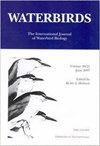Population Numbers of the Magellanic Penguin along Its Central-Southern Distribution in Argentina: An Update after 25 Years
IF 0.6
4区 生物学
Q3 ORNITHOLOGY
引用次数: 1
Abstract
Abstract. The overall population size and trend of the Magellanic Penguin (Spheniscus magellanicus) is uncertain and population estimates are available only for few locations. The last complete census along its central-southern distribution range in Argentina, province of Santa Cruz, was made in the 1990s. This study updates the breeding population size along Santa Cruz. Population estimates were compared with the last complete census, and trends were studied when it was possible. With 353,256 estimated breeding pairs, the overall population in Santa Cruz remained relatively stable after 25 years. The Santa Cruz population represents 31% of the Argentine Patagonian coast population and could represent between 22 and 30% of the species' global population. Colony sizes varied between 9 and 127,492 breeding pairs. Changes in abundance differed among locations, with individual colonies showing increasing, decreasing, or stable trends, which suggests that local factors determine population dynamics. The most significant increases (> 40%) were observed in the southern sector of Santa Cruz. Contrary to what was observed at the north of the distribution range in the province of Chubut, where trends of several colonies were inversely related to colony size, in Santa Cruz most of the largest colonies remained stable or even increased from the 1990s onwards.麦哲伦企鹅在阿根廷中南部分布的种群数量:25年后的更新
摘要麦哲伦企鹅(Spheniscus magellanicus)的总体种群规模和趋势是不确定的,种群估计仅在少数地点可用。上世纪90年代,在阿根廷的圣克鲁斯省,沿着其中南部分布范围进行了最后一次完整的人口普查。这项研究更新了圣克鲁斯沿岸的繁殖种群规模。人口估计与上一次完整的人口普查进行了比较,并在可能的情况下研究了趋势。25年后,圣克鲁斯的总体数量保持相对稳定,估计有353,256对繁殖对。圣克鲁斯的种群数量占阿根廷巴塔哥尼亚海岸种群数量的31%,可能占该物种全球种群数量的22%至30%。群体大小在9到127,492对繁殖对之间变化。丰度的变化因地而异,个别种群呈现增加、减少或稳定的趋势,这表明当地因素决定了种群动态。增幅最大的是圣克鲁斯南部地区(> 40%)。与在丘布特省分布范围北部观察到的情况相反,在那里,几个殖民地的趋势与殖民地规模成反比,在圣克鲁斯,大多数最大的殖民地从1990年代开始保持稳定甚至增加。
本文章由计算机程序翻译,如有差异,请以英文原文为准。
求助全文
约1分钟内获得全文
求助全文
来源期刊

Waterbirds
生物-鸟类学
CiteScore
1.30
自引率
0.00%
发文量
0
审稿时长
6-12 weeks
期刊介绍:
Waterbirds is an international scientific journal of the Waterbird Society. The journal is published four times a year (March, June, September and December) and specializes in the biology, abundance, ecology, management and conservation of all waterbird species living in marine, estuarine and freshwater habitats. Waterbirds welcomes submission of scientific articles and notes containing the results of original studies worldwide, unsolicited critical commentary and reviews of appropriate topics.
 求助内容:
求助内容: 应助结果提醒方式:
应助结果提醒方式:


